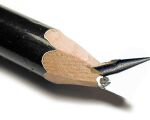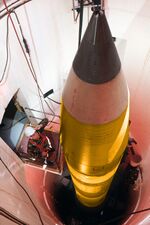Pencil
“And if I snap it down the middle...two pencils!”
A pencil was a sharp object once used to make drawings and write words on paper, before the dawning of the Internet era and CAD/CAM. The pencil's coup de grace was the eraser, hidden on the butt end of the pencil. It functioned as sort of a Delete key, and gave the young user practice in rubbing back and forth quickly.
Currently, there are better ways to do everything the pencil used to do. Pencils are now carried merely because they are an object with a sharp point that nevertheless lets the owner appear scholarly rather than threatening. Gordon Liddy advises air travelers how to make an arsenal, using only a pencil and a credit card, which will pass through jetway security and let the traveler defend himself against terrorists when stuck on a plane full of passive Americans. Pencils are a very subtle weapon that editors use to kill themselves. A great suicide tool.
The pencil is closely related to the pen. And the relationship is becoming ever more incestuous, as pencils are now being made in colors, like pens, whereas pens are now on the market with erasers, like pencils.
The pencil gets its name from William Penn, who famously wrote the purchase-and-sale agreement for the western half of New Jersey using the instrument. This fact, and the ability to retroactively change the document after several chumps wearing crowns signed it in pen, explains how he came to own all of Pennsylvania.
Types of pencil[edit]
Pencils come in many different types, reflecting the hardness and darkness of their writing. The British have devised several numbering systems for types of pencil, because things like that is simply what they do.
The most popular pencil is the № 2 pencil. It is called a № 2 pencil because its "lead" is made of feces. No pencil lead is actually made of lead, because people wet the lead with their tongues, for some reason. Students are told to bring № 2 pencils to exams, because that is a better way to vent hostility at teachers than all the other ways combined.
History[edit]
The United States, due to its large and faithful civil service, was once proudly known as a "nation of pencil-pushers." Every citizen carried a pencil with which to fill out innumerable forms. The ability to erase let the citizen change his mind and let regulations become marvelously confusing.
After the founding of the Soviet Union, pencils won the arms race. The Soviet Union, despite innumerable five-year plans, proved unable to distribute pencils to its people; whereas in the United States, pencils were sold on almost every street corner in most Hoovervilles, alongside apple vendors, for which the pencil made a perfect utensil.
President Bill Clinton not only signed legislation in pencil, but insisted that the legislation itself be written in pencil. This was a key to his governing philosophy of, "I meant it when I said (signed) it." He also used pencils for many other playful purposes when more suitable objects, such as cigars, were not available.
Every young American became accustomed to using pencils on a variety of standardized tests. This was at the dawn of the computer age, and the mark-sense reader was invented to read pencil-marks in circles on a form. Consequently, tests became exclusively Multiple Choice, with a system of partial credit that rewarded knowledge but gave a nod to the important skill of guessing wisely.
Such tests, like bar code at supermarkets, increased the productivity of teachers and the accuracy of their grades. This led George W. Bush to fatefully propose that schoolchildren be tested not just to prepare to enter college or law school, but every couple of years, whether they needed it or not. Teachers and students exchanged their pencils for picket signs, and the pencil lapsed into the merely ceremonial object that it is today.



